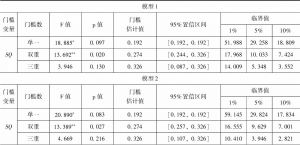论文
创新要素集聚、制度质量与产业结构高端化
摘要
不同优劣程度的制度质量对创新要素集聚产生不同的影响效应,促使创新要素出现不同的集聚形式,影响产业结构高端化。本文构建加入空间权重矩阵的内生增长模型分析产业结构高端化过程中的制度选择问题,进而实证探究了在制度质量的三个空间门槛阈值内各级创新要素集聚驱动我国产业结构高端化的空间作用效应。研究发现:三个空间门槛阈值内的制度质量分别促成初级、中级和高级创新要素集聚;创新要素集聚对产业结构高端化的空间作用效应与制度质量的优劣程度呈正比,技术溢出对产业结构高端化的空间作用效应与制度质量的优劣程度呈反比;制度质量对创新要素集聚驱动产业结构高端化的作用效应随着创新要素集聚层级的提升而下降;只有当区域的制度质量和创新要素集聚层级相契合时,采取对应的技术创新形式才能促进产业结构高端化。
作者
周璇 [作者简介]周璇(1989- ),女,苏州科技大学商学院讲师,研究方向为空间计量经济学。
陶长琪 (1967- ),男,江西财经大学统计学院教授,研究方向为经济计量分析与预测。
Zhou Xuan
Tao Changqi
检索正文关键字
论文目录
- 引言
- 1 文献综述
-
2 理论模型和理论假说
- 2.1 理论模型
- 2.1.1 各创新部门的运行环境
- 2.1.2 制度质量对创新要素集聚的影响
- 2.2 理论假说
- 2.1 理论模型
-
3 制度质量的空间门槛作用效应
- 3.1 变量测度与计量模型
- 3.1.1 数据来源与变量测算
- 3.1.2 实证模型
- 3.2 实证结果
- 3.1 变量测度与计量模型
-
4 不同制度选择下的创新要素集聚驱动产业结构高端化
- 4.1 制度差异下创新要素集聚驱动产业结构高端化的作用机制
- 4.2 变量测度与计量模型
- 4.2.1 变量测算
- 4.2.2 实证模型
- 4.3 实证结果
- 4.3.1 全局角度
- 4.3.2 局部角度
- 4.4 模型检验
- 结论和建议
相关文献
查看更多>>>











